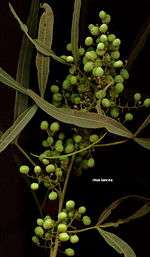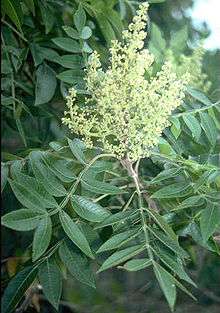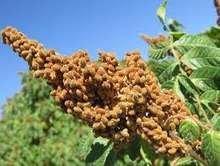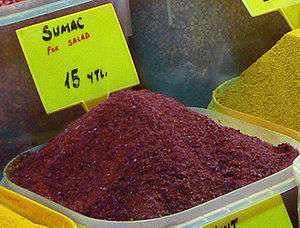Sumac
| Sumac | |
|---|---|
| Sumac fruit in the autumn season | |
| Scientific classification | |
| Kingdom: | Plantae |
| Clade: | Angiosperms |
| Clade: | Eudicots |
| Clade: | Rosids |
| Order: | Sapindales |
| Family: | Anacardiaceae |
| Subfamily: | Anacardioideae |
| Genus: | Rhus L.[1] |
| Type species | |
| Rhus coriaria | |
| Species | |
|
About 35 species; see text | |
Sumac (/ˈsjuːmæk/; also spelled sumach, sumaq) (Assyrian Neo-Aramaic: ܣܘܼܡܵܩܵܐ, translit. summāqāʾ, lit. 'red, red shift, turning red', Arabic: سُمّاق, translit. summāq), (Mishnaic Hebrew אוֹג=Og) is any one of about 35 species of flowering plants in the genus Rhus and related genera, in the family Anacardiaceae. The dried and powdered fruits of Rhus coriaria are used as a spice in Middle Eastern cuisine. Sumacs grow in subtropical and temperate regions throughout the world, especially in East Asia, Africa, and North America.[3][4]
Description
Sumacs are shrubs and small trees that can reach a height of 1–10 m (3.3–32.8 ft). The leaves are spirally arranged; they are usually pinnately compound, though some species have trifoliate or simple leaves. The flowers are in dense panicles or spikes 5–30 cm (2.0–11.8 in) long, each flower very small, greenish, creamy white or red, with five petals. The fruits form dense clusters of reddish drupes called sumac bobs. The dried drupes of some species are ground to produce a tangy, crimson spice.[5][6]
This shrub or low tree, belonging to the family Anacardiadeae, which includes the terebinth and the pistachio, grows wild in the groves of Israel. The tree is dioecious, with pinnate leaves containing a high proportion of tannin which is used in the manufacture of leather, whence its Hebrew name og ha-bursaka'im ("tanner's sumac"). The female trees bear reddish fruits (in Arabic sumac means "red") arranged in dense clusters. The fruits are shaped like lentils, and are hairy with an acrid taste. It is used as a spice by some Oriental communities, in the Colonial United States (giving rise to the tradition of "pink lemonade"), and in present day North America. Its fruits (R. thyphina, staghorn sumac), soaked in cold water, make a delicious and refreshing, vitamin C rich wild beverage. It was cultivated in mishnaic times and is therefore reckoned with those fruits to which the law of pe'ah applied (Pe'ah 1:5), but in Judea where it grew wild abundantly it was not very highly valued and a lenient attitude was adopted about pe'ah (Dem. 1:1).
Sumacs propagate both by seed (spread by birds and other animals through their droppings), and by new shoots from rhizomes, forming large clonal colonies.
Taxonomy



The taxonomy of Rhus has a long history, with de Candolle proposing a subgeneric classification in 1825, with five sections. At its largest circumscription, Rhus, with over 250 species, has been the largest genus in the family Anacardiaceae.

Other authors used subgenera and placed some species in separate genera, hence the use of Rhus sensu lato and Rhus sensu stricto (s.s.). One classification uses two subgenera, Rhus (about 10 spp.) and Lobadium (about 25 spp.), while at the same time Cotinus, Duckera, Malosma, Metopium, Searsia and Toxicodendron segregated to create Rhus s.s.. Other genera that have been segregated include Actinocheita and Baronia. As defined, Rhus s.s. appears monophyletic by molecular phylogeny research. However the subgenera do not appear to be monophyletic. The larger subgenus, Lobadium, has been divided further into sections, Lobadium, Terebinthifolia. and Styphonia (two subsections).[7][8][9]
Selected species
- Africa (all of these species have been transferred to the genus Searsia)
- Rhus acocksii Moffett
- Rhus albomarginata Sond.
- Rhus angustifolia L.
- Rhus batophylla Codd
- Rhus baurii Schönl.
- Rhus bolusii Sond. ex Engl.
- Rhus brenanii Kokwaro
- Rhus burchellii Sond. ex Engl.
- Rhus carnosula Schönl.
- Rhus chirindensis Bakh.f.
- Rhus ciliata Licht. ex Schult.
- Rhus crenata Thunb.
- Rhus cuneifolia L.
- Rhus dentata Thunb.
- Rhus discolor E.Mey. ex Sond.
- Rhus dissecta Thunb.
- Rhus divaricata Eckl. & Zeyh.
- Rhus dracomontana Moffett
- Rhus dregeana Sond.
- Rhus dura Schönl.
- Rhus engleri Britt.
- Rhus erosa Thunb.
- Rhus fastigiata Eckl. & Zeyh.
- Rhus gerrardii (Harv. ex Engl.) Diels.
- Rhus glauca Thunb.
- Rhus gracillima Engl.
- Rhus grandidens Harv. ex Engl.
- Rhus gueinzii Sond.
- Rhus harveyi Moffett
- Rhus horrida Eckl. & Zeyh.
- Rhus incisa L.f.
- Rhus kirkii Oliv.
- Rhus keetii Schönl.
- Rhus krebsiana Presl ex Engl.
- Rhus laevigata L.
- Rhus lancea L.f. (syn. Searsia lancea)
- Rhus leptodictya Diels.
- Rhus loemnodia Ruckt.
- Rhus longipes Engl.(1883)
- Rhus longispina Eckl. & Zeyh.
- Rhus lucens Hutch.
- Rhus lucida L.
- Rhus macowanii Schönl.
- Rhus magalismontana Sond.
- Rhus maricoana Moffett
- Rhus marlothii Engl.
- Rhus microcarpa Schönl.
- Rhus montana Diels
- Rhus natalensis Bernh. ex Krauss
- Rhus nebulosa Schönl.
- Rhus pallens Eckl. & Zeyh.
- Rhus pendulina Jacq.
- Rhus pentheri Zahlbr.
- Rhus pondoensis Schönl.
- Rhus populifolia E.Mey. ex Sond.
- Rhus problematodes Merxm. & Roessl.
- Rhus pterota Presl
- Rhus pygmaea Moffett
- Rhus pyroides Burch.
- Rhus quartiniana A.Rich.
- Rhus refracta Eckl. & Zeyh.
- Rhus rehmanniana Engl.
- Rhus rigida Mill.
- Rhus rimosa Eckl. & Zeyh.
- Rhus rogersii Schönl.
- Rhus rosmarinifolia Vahl
- Rhus rudatisii Engl.
- Rhus scytophylla Eckl. & Zeyh.
- Rhus sekhukhuniensis Moffett
- Rhus stenophylla Eckl. & Zeyh.
- Rhus tenuinervis Engl.
- Rhus tomentosa L.
- Rhus transvaalensis Engl.
- Rhus tridactyla Burch.
- Rhus tumulicola S.Moore
- Rhus undulata Jacq.
- Rhus volkii Suesseng.
- Rhus wilmsii Diels.
- Rhus zeyheri Sond.
- Asia
- Rhus chinensis Mill. - Chinese sumac
- Rhus delavayi Franchet
- Rhus hypoleuca
- Rhus potaninii Maximowicz (syn. Toxicodendron potaninii) - Chinese varnish tree
- Rhus punjabensis - Punjab Sumac
- Rhus verniciflua (syn. Toxicodendron vernicifluum, lacquer tree)
- Rhus succedanea (syn. Toxicodendron succedaneum)
- Australia, Pacific
- Rhus taitensis Guill. (Northeast Australia, Malesia, Micronesia, French Polynesia)
- Rhus sandwicensis A.Gray - neneleau (Hawaii)
- Mediterranean Basin
- Rhus coriaria - Tanner's sumac
- Rhus pentaphylla (transferred to the genus Searsia)
- Rhus tripartita (transferred to the genus Searsia)
- Middle East (all of these species have been transferred to the genus Searsia)
- Rhus aucheri Boissier
- Rhus sp. nov. A A.Miller (Yemen's Socotra Archipelago)[10]
- Rhus thyrsiflora Balf. f.
- Eastern North America
- Rhus aromatica - fragrant sumac
- Rhus copallinum - winged or shining sumac
- Rhus glabra - smooth sumac
- Rhus lanceolata - prairie sumac
- Rhus michauxii - Michaux's sumac
- Rhus typhina - staghorn sumac
- Rhus toxicodendron (syn. Toxicodendron radicans, poison ivy)
- Rhus vernix (syn. Toxicodendron vernix, poison sumac)
- Western North America
- Rhus choriophylla - Mearn's sumac (Arizona, New Mexico)
- Rhus diversiloba (syn. Toxicodendron diversilobum, - poison oak)
- Rhus laurina (syn. Malosma laurina) - laurel sumac
- Rhus integrifolia - lemonade sumac
- Rhus glabra - smooth sumac
- Rhus kearneyi - Kearney sumac
- †Rhus malloryi Wolfe & Wehr - extinct; Ypresian
- Rhus microphylla - desert sumac, littleleaf sumac
- Rhus ovata - sugar sumac
- †Rhus rooseae Manchester - extinct; Middle Eocene
- Rhus trilobata Nutt. - skunkbush sumac
- Rhus virens - evergreen sumac
- Rhus muelleri - Müller's sumac (northeast Mexico)
Etymology
The word 'sumac' traces its etymology from Old French sumac (13th century), from Mediaeval Latin sumach, from Arabic summāq (سماق), from Syriac summāq (ܣܡܘܩ)- meaning "red".[11][12][13]
Cultivation and uses

Species including the fragrant sumac (R. aromatica), the littleleaf sumac (R. microphylla), the skunkbush sumac (R. trilobata), the smooth sumac, and the staghorn sumac are grown for ornament, either as the wild types or as cultivars.
Spice and beverage flavoring
The fruits (drupes) of Rhus coriaria are ground into a reddish-purple powder used as a spice in Middle Eastern cuisine to add a tart, lemony taste to salads or meat.[5] In Arab cuisine, it is used as a garnish on meze dishes such as hummus and tashi, and is added to salads in the Levant, as well as being one of the main ingredients in Palestine's national dish, Musakhan. In Afghan, Armenian, Bangladeshi, Indian, Iranian, Jewish, Israeli Israeli cuisine, Kurdish and Pakistani cuisines, sumac is added to rice or kebab. In Azerbaijani, Central Asian, Jordanian and Turkish cuisines, it is added to salads, kebab and lahmajoun. Rhus coriaria is used in the spice mixture za'atar.[14][15]
In North America, the smooth sumac (R. glabra) and the staghorn sumac (R. typhina) are sometimes used to make a beverage termed "sumac-ade", "Indian lemonade", or "rhus juice". This drink is made by soaking the drupes in cool water, rubbing them to extract the essence, straining the liquid through a cotton cloth, and sweetening it. Native Americans also use the leaves and drupes of the smooth and staghorn sumacs combined with tobacco in traditional smoking mixtures.
Dye and tanning agent
The leaves of certain sumacs yield tannin (mostly pyrogallol-type), a substance used in vegetable tanning. Notable sources include the leaves of R. coriaria, Chinese gall on R. chinensis, and wood and roots of R. pentaphylla. Leather tanned with sumac is flexible, light in weight, and light in color. One type of leather made with sumac tannins is morocco leather.[16]
The dyeing property of sumac needed to be considered when it was shipped as a fine floury substance in sacks as a light cargo accompanying heavy cargoes such as marble. Sumac was "especially dangerous" to marble. "When sumac dust settles on white marble, the result is not immediately apparent, but if it once becomes wet, or even damp, it becomes a powerful purple dye, which penetrates the marble to an extraordinary depth."[17]
Medicinal use
Sumac was used as a treatment for several different ailments in medieval medicine, primarily in Middle Eastern and South Asian countries (where sumac was more readily available than in Europe). An 11th-century shipwreck off the coast of Rhodes, excavated by archeologists in the 1970s, contained commercial quantities of sumac drupes. These could have been intended for use as medicine, as a culinary spice, or as a dye.[18] Staghorn sumac is a powerful antioxidant, with ORAC rating over 1500 μmol TE/g.[19] Also, the anti hypertension effect of sumac has been investigated and a clinical trial study showed significant effects of R. coriaria on decrease the blood pressure in hypertensive patients[20]
Other uses
Some beekeepers use dried sumac bobs as a source of fuel for their smokers.[21]
Sumac stems also have a soft pith in the center that is easily removed to make them useful in traditional Native American pipemaking. They were commonly used as pipe stems in the northern United States.[22]
Dried sumac wood fluoresces under long-wave ultraviolet radiation.[23]
Toxicity and control
Some species formerly recognized in Rhus, such as poison ivy (Toxicodendron radicans, syn. Rhus toxicodendron), poison oak (Toxicodendron diversilobum, syn. Rhus diversiloba), and poison sumac (Toxicodendron vernix, syn. Rhus vernix), produce the allergen urushiol and can cause severe allergic reactions. Poison sumac may be identified by its white drupes, which are quite different from the red drupes of true Rhus species.
Mowing of sumac is not a good control measure, since the wood is springy, resulting in jagged, sharp-pointed stumps when mown. The plant will quickly recover with new growth after mowing.[24] Goats have long been considered an efficient and quick removal method, as they eat the bark, which helps prevent new shoots. Sumac propagates by rhizome. Small shoots will be found growing near a more mature sumac tree via a shallow running root quite some distance from the primary tree. Thus, root pruning is a means of control without eliminating the species altogether.
References
- ↑ "Rhus L." Germplasm Resources Information Network. United States Department of Agriculture. 2009-11-23. Retrieved 2010-02-09.
- ↑ "Rhus L." TROPICOS. Missouri Botanical Garden. Retrieved 2010-02-09.
- ↑ 12. Rhus Linnaeus, Flora of China
- ↑ Rhus L., USDA PLANTS
- 1 2 Sumac is also used as a tisane or tea substitute by boiling the dried leaves.Sumac - Ingredients - Taste.com.au
- ↑ Poison Sumach and Good Sumac Shrubs
- ↑ Miller et al 2001.
- ↑ Pell 2004.
- ↑ Andrés-Hernández & Terrazas 2009.
- ↑ Miller, A. 2004. Rhus sp. nov. A. 2006 IUCN Red List of Threatened Species. Downloaded on 23 August 2007.
- ↑ Etymology of Sumac at Etymonline.com
- ↑ Weekley, Ernest (1921). An etymological dictionary of modern English. Archived from the original on 12 October 2014.
- ↑ Quattrocchi, Umberto (2000). CRC World Dictionary of Plant Names: Common Names, Scientific Names, Eponyms, Synonyms, and Etymology. IV R-Z. Taylor & Francis US. p. 2306. ISBN 978-0-8493-2678-3.
- ↑ Christine Manfield, Charlie Trotter, Ashley Barber -Spice 2008 - Page 28 "Sumac This reddish ground spice is made from the berries of the sumac bush,"
- ↑ Aliza Green Field Guide to Herbs & Spices: How to Identify, Select, and Use ... 2006 - Page 257 "In Lebanon, Syria, and Egypt, sumac is cooked with water to a thick sour paste, which is added to meat and vegetable dishes; this method was also common in Roman times. Sumac appears in the Jordanian spice mixture za'atar (page 288) ..."
- ↑ Davis, Charles T. The Manufacture of Leather. Pub: Henry Carey Baird 1885. May be downloaded from: https://archive.org/details/manufactureoflea01davi
- ↑ Lee, Arthur (1888). Marble and marble workers: a handbook for architects, artists, masons and students. London: Crosby Lockwood & Son. p. 19.
- ↑ Bass, George Fletcher; Allan, James W. (2003). Serçe Limanı: An Eleventh-century Shipwreck. Texas A&M University Press. p. 506. ISBN 978-0-89096-947-2.
- ↑ Wu, T; McCallum, JL; Wang, S; Liu, R; Zhu, H; Tsao, R. "Evaluation of antioxidant activities and chemical characterisation of staghorn sumac fruit (Rhus hirta L.)". Food Chem. 138: 1333–40. doi:10.1016/j.foodchem.2012.10.086. PMID 23411251.
- ↑ Ardalani, Hamidreza; Moghadam, Maryam Hassanpour; Rahimi, Roja; Soltani, Jalal; Mozayanimonfared, Azadeh; Moradi, Mehdi; Azizi, Ali (2016). "Sumac as a novel adjunctive treatment in hypertension: a randomized, double-blind, placebo-controlled clinical trial". RSC Advances. 6 (14): 11507–11512. doi:10.1039/C5RA22840A. ISSN 2046-2069.
- ↑ Avitabile, Alphonse. Sammataro, Diana. The Beekeeper's Handbook. Publisher: Comstock 1998. ISBN 978-0801485039
- ↑ Lewis, Thomas H. The Medicine Men: Oglala Sioux Ceremony and Healing. Publisher: University of Nebraska Press. 1992. ISBN 978-0803279391
- ↑ Hoadley, R. Bruce (2000). "Chapter 5: Other Properties of Wood". Understanding Wood: a Craftsman's Guide to Wood Technology (2 ed.). Taunton Press. pp. 105–107. ISBN 978-1-56158-358-4.
- ↑ Ortmann, John; Miles, Katherine L.; Stubbendieck, James H.; Schacht, Walter (1997). "Management of Smooth Sumac on Grasslands". University of Nebraska-Lincoln.
Further reading
- RO Moffett. A Revision of Southern African Rhus species FSA (Flora of South Africa) vol 19 (3) Fascicle 1.
- Schmidt, Ernst; Lötter, Mervyn; McCleland, Warren (2002). Trees and Shrubs of Mpumalanga and Kruger National Park. Jacana Media. ISBN 978-1-919777-30-6.
- Andrés-Hernández, A. R.; Terrazas, Teresa (October 2009). "Leaf architecture of Rhus s.str. (Anacardiaceae)" (PDF). Feddes Repertorium. 120 (5–6): 293–306. doi:10.1002/fedr.200911109.
- Miller, Allison J.; Young, David A.; Wen, Jun (2001). "Phylogeny and Biogeography of Rhus (Anacardiaceae) Based on ITS Sequence Data". International Journal of Plant Sciences. 162 (6): 1401–1407. doi:10.1086/322948.
- Pell, Susan Katherine (May 2004). Molecular systematics of the cashew family (Anacardiaceae) (PDF). Department of Biological Sciences, Louisiana State University. Archived from the original (PhD thesis) on 2008-08-21.
| Wikimedia Commons has media related to Rhus. |